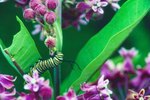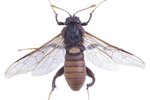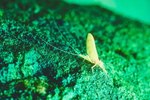
Distinguished by the bright blue scales on the insides of their wings, morpho butterflies are natives of the rain forests of Mexico, Central America and South America. Though their beauty is limited by a brief life cycle consisting of no more than 115 days, the butterflies spend most of their time eating and reproducing. The morphos' diet changes drastically throughout their short lives.
Hungry Caterpillars
Like all caterpillars, morpho young feed on the leaves of plants. According to the St. Louis Zoo, the reddish-brown caterpillars splotched with lime-green prefer the taste of plant leaves from the pea family. Morpho caterpillars molt five times before reaching the pupal stage, whereupon they form jade-green chrysalises that may respond with ultrasonic sounds when disturbed. When the pupae have matured, they emerge from their chrysalises as adult morpho butterflies.
Eating Like Adults
As adult butterflies, morphos are no longer able to chew leaves, according to the Rainforest Alliance website. Their main method of dining is through their probosces, or long mouth pieces, which they use like drinking straws to sip at their food. Adult morphos spend most of their life in the understory, or lower shrubs and trees, of their forest homes. They taste scents in the air with specialized sensors on the butterflies' legs and by the antennae on their heads.
Favorite Foods
While vegetarian caterpillars munch on pea plants, adult morphos prefer a variety of foods not limited to the juice of fermenting fruit, decomposing animals, tree sap, fungi and mud that contains rich nutrients, according to the Audubon Nature Institute website. When sampling fermented fruit, butterflies may become inebriated, allowing for easy capture. As they often feed on certain fungi, the butterflies are thought to be instrumental in the distribution of fungi spores.
Predators and Threats
Morpho butterflies have few natural predators, though their habitats are threatened by deforestation, according to the Rainforest Alliance. Most predators leave the butterflies alone, as the adults are toxic, having obtained this protection from their plant diet as caterpillars. Morphos are difficult for predators to catch, thanks to their natural defenses that can fool predator eyes. Birds such as the flycatcher and jacamar are among the few that may still prey upon morpho butterflies.
References
Photo Credits
-
Hemera Technologies/PhotoObjects.net/Getty Images



